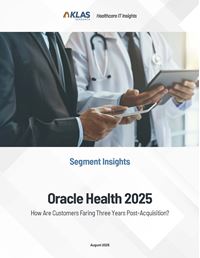

Cerner Soarian Financials Pulse Check 2022
Understanding Soarian Financials’ Performance as a Possible Indicator of RevElate’s Success
In October 2021, Cerner introduced RevElate as their go-forward patient accounting platform instead of Cerner Patient Accounting (CPA). According to Cerner, RevElate will be built on elements of both CPA and Soarian Financials. The number of Soarian Financials customers has decreased over the years, and because the solution was never Cerner’s go-forward platform, KLAS has not actively collected research on it for several years. However, since the RevElate announcement, organizations have wondered whether the Soarian Financials customer experience is a possible indicator of the RevElate customer experience. This report—the second in a series of Cerner-focused reports—examines the state of Soarian Financials today, based on data collected from customers over the past 24 months with an emphasis on interviews conducted since the RevElate announcement. In future research, KLAS intends to collect perceptions from additional Cerner customers and validate the impacts customer organizations have seen from Cerner’s recent changes.

Revenue Cycle Implementations Are Cerner’s Biggest Challenge; No Indication from Soarian Customer Experience That This Will Be Different with RevElate
Over the years, Cerner customers—regardless of which revenue cycle product they use—have reported challenges with the quality of their revenue cycle implementation and the resources assigned to their organization. These customers have mentioned Cerner’s consultants often lack experience and knowledge about the product and about provider organizations’ workflows, resulting in few customers being set up for success. In a recent study, KLAS interviewed 30 Cerner revenue cycle customers about the RevElate announcement; more than one-third doubted Cerner’s ability to address implementation challenges and retain qualified staff capable of facilitating successful outcomes. Many of these customers question the vendor’s ability to successfully implement RevElate once it is released and are waiting to hear Cerner’s plan for addressing issues.

In this current research, Soarian Financials customers who went live under Cerner say they experienced implementation mistakes, and even today, some known issues haven’t been fixed. These problems have persisted throughout Cerner’s ownership of Soarian Financials, with customers saying they are still recovering from poor implementations that occurred several years ago (see commentary below). Additionally, training is often a challenge; many respondents say Cerner’s training resources are difficult to access, lack substance, and often don’t align with the implemented workflows. No respondents are highly satisfied with the initial or ongoing training, and only a few report the training met their needs. It remains to be seen what processes Cerner will employ when they roll out RevElate.
Older Customer’s Implementation Experience
“Soarian Financials wasn’t implemented well. Cerner did the implementation themselves, and they did not include our facility’s staff members. We don’t know what they built, why they built it, how they built it, what their mind-set was when they built it, what they turned on, or what they didn’t turn on. When there isn’t staff participation in a major build like that, it leaves providers in a bad spot to support the system. We call Cerner when we are trying to figure things out, and I have also had to hire third-party resources to help support the application while we try to bring our team up to speed.” —IT director (interviewed February 2016)
Newer Customer’s Implementation Experience
“Cerner’s team members don’t learn from the mistakes that they make during implementations. They carry those mistakes from site to site, and they have admitted to repeating certain errors at other sites. Soarian Financials was touted as one of the best hospital financial systems out there. Part of the reason for Cerner’s acquisition of Siemens was so that Cerner could glean things from Soarian Financials and bring those things in to other products. However, we have had issues with Soarian Financials. Our A/R went way up during our implementation, and it took a long time to come back down, even with assistance. Our implementation of Soarian Financials was very painful. We are still reeling from that.” —COO (interviewed March 2022)
With Time, Soarian Financials Becomes More Workable Than Cerner Patient Accounting
Many longtime customers describe Soarian Financials as a solid system that has driven outcomes in both small and large organizations. Though respondents acknowledge it isn’t the flashiest option, over 80% are satisfied overall. Those who have used the solution for a while say it takes time to get the system to a workable state, but they have learned what to expect regarding usability and workflows, and their own internal efforts have enabled them to achieve tangible financial outcomes. Newer customers (live for five years or less) are much more likely to report usability difficulties and are significantly less satisfied than longer-term customers. Notably, customer satisfaction plateaus after five years of solution use and does not substantially improve beyond that point. Respondents highlight Cerner’s efforts over the past few years to improve executive involvement, saying there has been increased engagement from the account team and more proactive customer support. Overall, the product is seen in a much more positive light than CPA—respondents say they have resisted moving to CPA because a large portion of CPA customers (57%) are dissatisfied with persistent issues around implementations, functionality, and workflows.

Soarian Financials Requires More Bolt-Ons Than Customers Expect
As mentioned above, many respondents believe Soarian Financials is solid, and they have been able to fine-tune it over the years to process bills in a consistent, timely manner. However, about 25% of respondents feel the product is antiquated and hasn’t been kept up to date. In addition, 43% of respondents report frustration at having to use more third-party bolt-on applications than expected to achieve the necessary level of functionality. Secondary claim billing, price estimation, patient billing, eligibility, and medical record duplicity checking are all areas in which customers wish Cerner would develop their own capabilities instead of depending on third parties. Respondents believe having native capabilities in these areas would make Soarian Financials a stronger product. Some customers bought the solution believing it was a complete revenue cycle offering and were frustrated to discover that it required bolt-ons that don’t seamlessly integrate. These integration challenges negatively impact workflow and efficiency. Additionally, several respondents say the interface between Soarian Financials and Cerner’s EMR is insufficient.

“One thing that I don’t understand is that Soarian Financials is a strong, powerful financial system with the backing of expert minds, but we need so many third-party vendors to make it work. I want Cerner to develop it out a bit further and eliminate third-party vendors.” —Business office director
“We bought what we thought were integrated solutions, and now Cerner has a lot of add-ons that cost money and don’t work seamlessly. Cerner charges us for every little thing. Our biggest pain point is that Cerner is moving away from development and toward partnerships.” —VP of IT
“It would be ideal if Cerner could build the system out a little stronger so that we could eliminate some third-party vendors. I want Cerner’s system to be so strong that we don’t need to buy other products to make things work.” —CIO
Increasing Percentage of Soarian Financials Customers Report Nickel-and-Diming
Since Soarian Financials was acquired by Cerner in 2015, an increasing percentage of customers have reported nickel-and-diming. Respondents feel the product is expensive and believe Cerner has too many additional charges, including for product changes needed to meet regulatory requirements. Respondents would prefer regulatory changes be included in the support cost and in the product’s standard maintenance. Having to pay for third-party applications to address Soarian Financials’ functionality gaps is another sticking point for respondents who feel nickel-and-dimed; they wish Cerner would develop their own functionality instead of making customers depend on third-party functionality, which costs additional money.

Current Soarian Customers Want Greater Clarity around How RevElate Will Impact Their Future
Before Cerner’s RevElate announcement, some Soarian Financials customers expressed concerns about Cerner not upholding their commitment to continually develop Soarian Financials. Now, respondents want more clarity around how and when the RevElate decision will impact them. Several feel that they have been left in the dark and that Cerner has communicated more information to Millennium customers. Oracle’s acquisition of Cerner has only heightened respondents’ uncertainty about what their future holds, particularly around pricing, product implementation, and the vendor relationship. Customers would like Cerner to be more transparent and clearer in their communication around RevElate.
“We have been trying to get clarification from Cerner about what the transition to RevElate looks like for us since we are a Soarian Financials customer. The communication has been more focused on the Millennium customers. . . . But we are trying to get a sense of how big the lift is going to be for us and what the timeline is. I haven’t heard back anything with as much substance as I would like.” —Business office director
“Part of Cerner’s new long-term plan with Oracle is to leverage Soarian Financials for billing and then move all the billing pieces to the Millennium product, which is a horrible product. Oracle isn’t known to be very nice to their customers. However, we have invested in Cerner, so we are looking at Cerner RevElate. Cerner is pushing us to get Cerner RevElate. Without a doubt, they are going to make our lives hell. Cerner will make us spend a lot of money and change everything, and then no one will know how to do anything. Cerner is going to have people come in and implement Cerner RevElate, and then they will leave and tell us nothing.” —IT director
“Cerner has their challenges. They are growing, and now they have Oracle. . . . Cerner needs to figure out what they are doing. That is what kills Cerner the most. They don’t know what they will do next, and then they tell us that we must take something and that we have no choice.” —IT director

About This Report
Each year, KLAS interviews thousands of healthcare professionals about the IT solutions and services their organizations use. For this report, interviews were conducted over the last 24 months (commentary comes from interviews conducted over the last 6 months) using KLAS’ standard quantitative evaluation for healthcare software, which is composed of 16 numeric ratings questions and 4 yes/no questions, all weighted equally. Combined, the ratings for these questions make up the overall performance score, which is measured on a 100-point scale. The questions are organized into six customer experience pillars—culture, loyalty, operations, product, relationship, and value.

Sample Sizes
Unless otherwise noted, sample sizes displayed throughout this report (e.g., n=16) represent the total number of unique customer organizations interviewed. However, it should be noted that to allow for the representation of differing perspectives within any one customer organization, samples may include surveys from different individuals at the same organization. The table below shows the total number of unique organizations interviewed as well as the total number of individual respondents.
Some respondents choose not to answer particular questions, meaning the sample size can change from question to question. When the number of unique organization responses for a particular question is less than 15, the score for that question is marked with an asterisk (*) or otherwise designated as “limited data.” If the sample size is less than 6, no score is shown. Note that when a vendor has a low number of reporting sites, the possibility exists for KLAS scores to change significantly as new surveys are collected.


Writer
Sarah Brown

Designer
Jess Wallace-Simpson

Project Manager
Robert Ellis
This material is copyrighted. Any organization gaining unauthorized access to this report will be liable to compensate KLAS for the full retail price. Please see the KLAS DATA USE POLICY for information regarding use of this report. © 2026 KLAS Research, LLC. All Rights Reserved. NOTE: Performance scores may change significantly when including newly interviewed provider organizations, especially when added to a smaller sample size like in emerging markets with a small number of live clients. The findings presented are not meant to be conclusive data for an entire client base.








